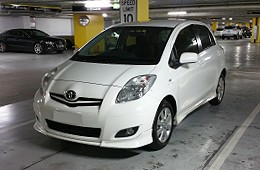Visit the old website: |
Suzuki Hayabusa Stuff:  Tech Specifications Tech Specifications Color Schemes |
Featured story lines: LAMS and Commuter motorcycles Motorcycle Picture Galleries Motorcycle Specs and Pricing |
Small Car Technology

In the recent past (namely prior to 2017) small cars have always been on the lowest recipient of technology in terms of performance, safety and comfort. The only car company I know that have tried to break the mould prior to 2017 is MINI and have had some success. Other companies have simply made smaller cars although they aren’t that small.
The small cars I’m referring to are the Honda Jazz, Toyota Yaris, Mazda 2, VW Polo and smaller. The Toyota Corolla, Mazda3, Ford Focus, Honda Civic are NOT small cars except if you have them from the 1980’s. Small cars are those than can fit 4 adults easily but not 5.
The development of modern technology means that small in size does not mean small inside! They have done clever things like made the seats ‘cab forward designs’, longer wheelbases and adjustable front and rear seat configuration and made them wider and not too much longer. They also meet the same safety standards as much larger cars in the standardised crash tests such as NCAP. These are the physical developments but there are plenty more technology inclusions that are flow from more expensive models.
Aside from it’s construction additional technology such as airbags, braking systems, traction control systems are all shared with their larger models. In fact some models have the latest low speed auto braking ahead of their larger models. Based on personal experience they are probably safer at avoiding accidents due to their smaller size, good power to weight ratios and that their braking systems don’t have as much weight to stop or control as larger cars.
In terms of engines smaller cars often have one older, dedicated engine model in the range and another additional engine option shared with their larger models in the brand’s range. As a result of the engine and other shared components in the drive train mean that they are often faster than larger models and more reliable due to less mechanical stress due to lighter weight. Fuel consumption is also improved.
In terms of refinement you will surprised at how civilised the interior noise levels and smoothness the driving experience is. Small cars I’ve driven were all good in normal speeds and situations and they are easier to drive, it’s hard to explain. It’s not that much different to larger or more expensive models – ‘bang for you buck’ is something that really applies to these cars. Some say the handling limits are lower, I say no because in everyday driving they are usually better since that is exactly what they are designed to do.
It’s difficult to describe but if you checkout my prior post on the comparison may help. Small-car-comfort. In terms of driving, for example gear changes either auto or manual change smoothy, engine vibes are not different to any other car I’ve driven, steering feel is always catered to lighter and tighter turning circle, ride is a little busier, road noise is purely dependent on your choice of tyres and regardless engines are always responsive or zippy from nay standing start. It always initially feels faster regardless of speed.
Now, the lack of engine capacity and gearing are clear on the freeway but optioned with a higher performance engine they perform just as well if not better. Small cars are still designed for city and suburb commuting rather than long distance drives which is “so 1980’s” since in the increasingly congested roads the small car is in it’s element.
The increasingly key feature in new cars for 2017 is the in car entertainment system that can connect with your mobile phone. All the small cars have systems that are the same as their larger and more expensive models. The quality is virtually the same as the more expensive models too! at least for the Australian market which is a bit of a rip off. That said these systems are mostly optional anyway so why not have these options here?
I’m posting this because these are the small car issues that went through my mind as I was shopping for my own small car.
